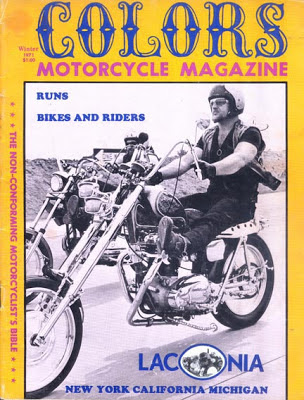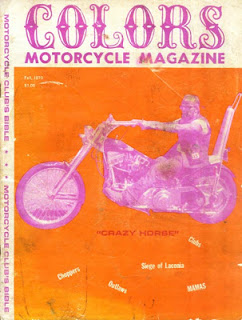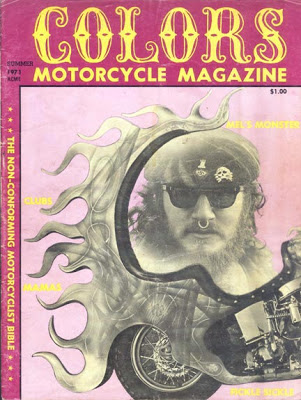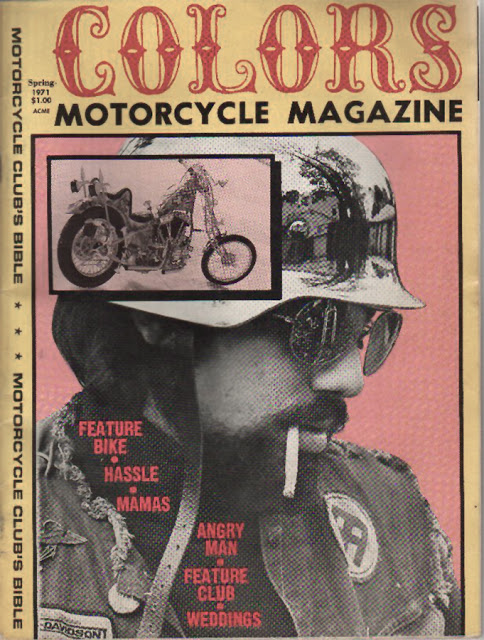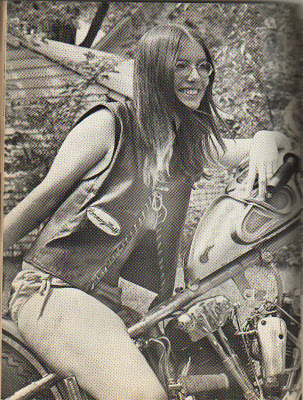not much browsing these days, as those of you who keep up with my FB hijinks probably know I’ve been buried in motorcycle guts instead of trippin’ along that yellow brick road. But bear with me, I haven’t abandoned the blog 😉
 Colors Motorcycle Magazine was a short lived mag predating Easyriders summer 1971 debut. Founded and edited by Phil Castle -a biker who ran a fuel oil delivery company in New Jersey- Colors was primarily focused on East Coast bike clubs and events. It suffered from poor distribution, the first issue was banned in a few states and money ran out before it caught on: it folded in 1971 after only five or so issues.
Colors Motorcycle Magazine was a short lived mag predating Easyriders summer 1971 debut. Founded and edited by Phil Castle -a biker who ran a fuel oil delivery company in New Jersey- Colors was primarily focused on East Coast bike clubs and events. It suffered from poor distribution, the first issue was banned in a few states and money ran out before it caught on: it folded in 1971 after only five or so issues.
Colors was a hands-on production, and flew in the face of a hostile reception by some newsstands and motorcycle shops. One of the original contributors to Colors was John Herlihy (aka Rogue), a one time Airforce gunner and photographer and the International President of the Huns Motorcycle Club of Bridgeport, Connecticut. Rogue went on to work for Paisano Publications after Colors folded and helped them launch Easyriders.
On Colors, Rogue comments –
“Colors was a good magazine, especially considering the people involved were bikers, not journalists making their living from publishing. The idea was to have a voice, and ‘Tell it like it is.’ Let people know what was going on, and in many cases, the other side of the story. The stories and information released to the news media by law enforcement and the government were often times misleading or untrue.
“It was also going to be a tool to support our efforts in repealing the Mandatory Helmet Laws and other injustices to motorcyclists. And in a way, it did do what it was intended to, by being imitated by larger publishers. The format carried over, and we were in an even better position to inform the bikers of America what was going on.”
Colors was oriented to (and focused on) the outlaw clubs, and was filled with black and white photos of various bikes, members, mamas, hangouts, and it even had a some tech oriented articles. Its statement of purpose, and format, given in the first issue (May 1970), reads as follows:
This is your magazine. That’s right, at last someone has come out with a magazine that is not afraid to be called an outlaw magazine. We will not hide behind technical articles or motorcycle manufacturer’s sales talk on those foreign bikes. COLORS magazine will not have a 80% AMA background.
We do not care what citizens won what AMA sanctioned race or event. Instead we will feature stories, articles, pictures, and so forth of so called outlaws and clubs.
We will not exclude all foreign bikes from our pages so long as they are directly or indirectly connected to a club, as there are some pretty hot foreign bikes that have been made into some beautiful custom jobs. Nor do we want to feature only choppers as there are many outlaws who do not ride choppers.
We will print any news of your club that you would approve of, as well as pictures, articles and events having to do with clubs.
COLORS will also feature interviews, technical material and some cheesecake for you red blooded studs. COLORS will be glad to print any gripe you may have or any pictures of your bikes, club or its members if you will send same to us.
This is a general idea of the format of COLORS (your) magazine, its success depends on your help and patronage.
Another Colors editorial explains further:
 Why do motorcyclists ravage the countryside, beating, raping, destroying? NOT TRUE. The news mediums pick a few isolated incidents of vandalism (and what-not), and blow these into movies or headlines. Fights are often started by non-riders testing the patience of the cyclist. As for rape; don’t tease the lion in his den, you won’t get clawed (old Chinese saying!). Cyclists do not commit more sexual crimes than other groups of society. They do not rove the streets looking for virginal daughters to rape. It’s not the bikies bag. As for destruction of property; people are confusing cyclists with extremist bombers and rioters. All one needs is to see a bike near the vicinity of the scene, and they scream, “motorcycle gang!”
Why do motorcyclists ravage the countryside, beating, raping, destroying? NOT TRUE. The news mediums pick a few isolated incidents of vandalism (and what-not), and blow these into movies or headlines. Fights are often started by non-riders testing the patience of the cyclist. As for rape; don’t tease the lion in his den, you won’t get clawed (old Chinese saying!). Cyclists do not commit more sexual crimes than other groups of society. They do not rove the streets looking for virginal daughters to rape. It’s not the bikies bag. As for destruction of property; people are confusing cyclists with extremist bombers and rioters. All one needs is to see a bike near the vicinity of the scene, and they scream, “motorcycle gang!”
Why does COLORS glorify the outlaw? We aren’t. We’re simply tired of a false image pushed on outlaws by ignorant citizens. Aren’t you?
Are these cyclists really as tough as they seem? Ask them.
 Colors did have some technical articles, usually one or two at the most per issue, but they were not the main
Colors did have some technical articles, usually one or two at the most per issue, but they were not the main
focus of the mag. Although the other cycle mags on the stands did cover choppers and customized bikes, they shied away from coverage of outlaw motorcycle clubs, with an occasional mention of them when the owner of a featured bike belonged to a club. Colors also had a “Club List” at the back of the mag, which was a list of the outlaw clubs from around the country, and got longer with each issue. After the movie Easy Rider the focus on the outlaws shifted from the clubs, and focused more on an outlaw biker lifestyle, generally outside of the clubs, but still connected to them in spirit.
Colors proclaiming itself as the “Motorcycle Club’s Bible”, helped some to consider it “the grungiest of them all” because of the outlaw slant and its cheesecake feature, “Mama of the Month” when compared to the other cycle mags on the racks at the time like Big Bike, Street Chopper, Chopper, etc.,
Colors was maverick, different from the rest, and it paved the way for the more club-friendly cycle mags to come, that took a lot from its format including biker fiction, and outlaw lifestyle, a la Easyriders, In The Wind, Iron Horse, Biker, Biker Lifestyle, Outlaw Biker, et al. All of which also would use the cheesecake pics of scantily clad or naked women with the cycles from then on.
-Excerpted from an article by Tom Brinkman, taken from bikerrogue.com
see also:
colorsmotorcyclemagazine.blogspot.com – Big thanks to these guys for posting what they got
Colors volume2 issue1 -1971-spring.pdf (full version, the only one I can find online)


